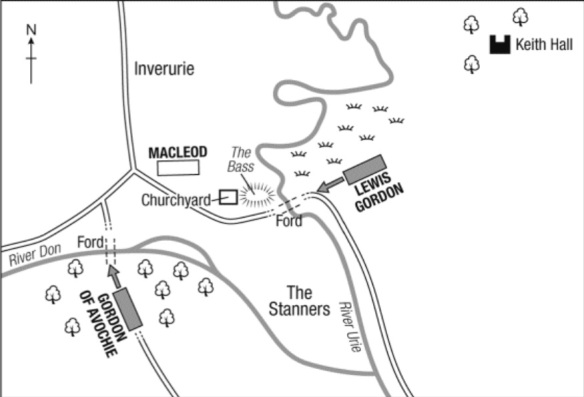Following its abortive invasion of England, Bonnie Prince Charlie’s Jacobite army marched back on to Scottish soil on 20 December 1745. New hope began to replace disappointment as provisions were requisitioned and new recruits – loath to fight in England, but happy to take up arms at home – arrived.
Charged with the responsibility of recruiting in Aberdeenshire during the prince’s English adventure was Lord Lewis Gordon. Some 800 men had been forced into service and money had been demanded of Aberdeen’s citizens. In response to requests for aid from the hard-pressed Aberdonians, the loyalist John Campbell, Earl of Loudoun, despatched MacLeod of MacLeod and 400 clansmen from Inverness. On the same day that Charles arrived back in Scotland, MacLeod reached Inverurie, about twelve miles from Aberdeen, where he was joined by a mixed force of Munros, led by George Munro of Culcairn, Mackenzies and Grants.
Lewis Gordon had retreated into Aberdeen, where his strength had mushroomed. In particular, he had acquired 300 Farquharsons and 150 piquets from Irish regiments in the French service, in company with Lord John Dummond, recently arrived by sea. Gordon also learned that, far from being concentrated at Inverurie, the loyalist forces lay scattered throughout the locality. For their part, MacLeod and Munro made no attempt to obtain intelligence about Gordon’s intentions; they simply presumed that he would be going south to join the main Jacobite army. In fact, Gordon had other plans.
At 9.00 a.m. on 23 December, 900 men, divided into two columns, marched out of Aberdeen – not to the south, but to the north-west, in the direction of Inverurie. Eventually, one column, led by Gordon of Avochie, swung to the west to approach Inverurie via the south bank of the River Don. The other, led by Lewis Gordon, continued on the main road before proceeding via Keith Hall to a ford on the River Urie.
MacLeod had no idea what was afoot. During the afternoon, he became aware of activity in the grounds of Keith Hall, but he made no attempt to investigate or to take the sensible precaution of securing the ford over the Urie. At 4.00 p.m., Lewis Gordon’s column was free to come streaming down the hill towards the river, creating panic in the town, where 300 of the loyalists were billeted.
To their credit, the MacLeods reacted quickly, firing upon the Jacobites as they forded the Urie although, positioned on the eastern edge of the town, they were too far away to do much damage. Had they taken possession of ‘The Bass’ – an area consisting of two mounds, the remains of a motte and bailey castle – and an adjacent churchyard, they might have checked the advance. Instead, a forward party of Lewis Gordon’s men was able to occupy both vantage points.
Arriving on the banks of the Don, the second Jacobite column also sent forth a detachment, forcing the Macleods to defend on two fronts. Their attempts at resistance appear to have been limited to a series of sallies which failed to stem the assault. Faced with the advance of both columns, they began to fall back through the town. The action was not prolonged, owing largely to the shortness of the day. With ‘night coming on apace’, it was remarked, neither side ‘could see to level their pieces’ and the MacLeods abandoned the fight, retreating northwards out of Inverurie and on to the River Spey. Estimates of the casualties sustained by the armies vary, but may not have amounted to many more than a dozen killed on each side.
This minor battle is now almost forgotten, lost in the greater scheme of things, but the Jacobite victory left them in control of Aberdeen, enabling them to continue their fundraising efforts for the cause.
Further reading
Peter Marren, Grampian Battlefields (Mercat Press, 1993).
